Alan Turing
An Architect of Modern Computing and AI
The Greatest Person of the 20th Century and the Father of AI, Alan Turing is a name that is synonymous with innovation and intellect. In his tragically short lifetime, Turing pushed the boundaries of what it means to think and be intelligent, both as human and machine.
Related: AI History | AI Research | Biographies
Alan Turing is one of the most influential figures of the 20th Century due to his theoretical work, practical contributions during World War II, social icon status, and legacy as a visionary thinker. His work in mathematics, computing, and AI laid the foundation for modern computer science, and it significantly impacted society in ways that resonate to this day.
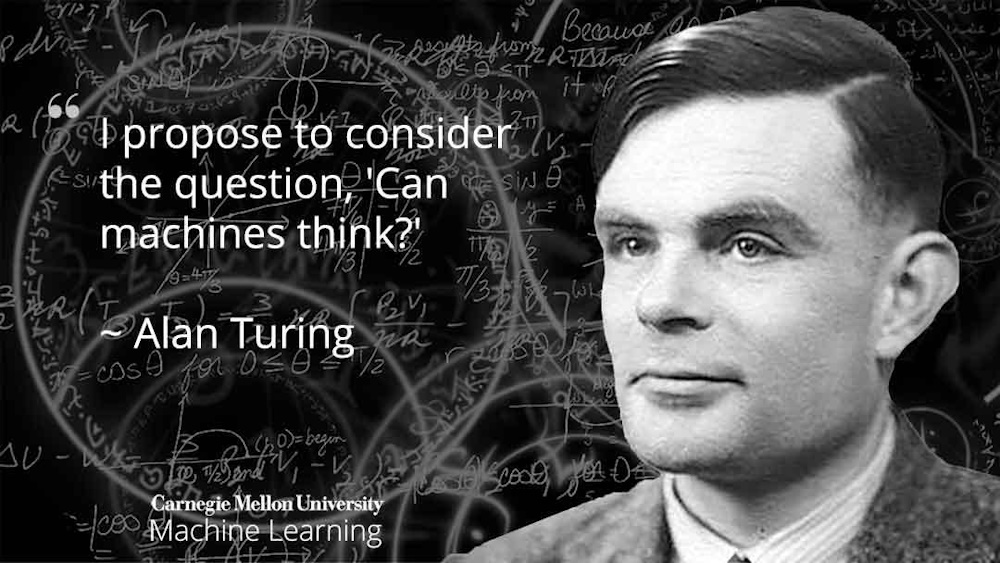
Turing's intellectual development was profoundly shaped by the philosophical thought of his time, as well as by key mentors and collaborators, including Bertrand Russell, Ludwig Wittgenstein, Alonzo Church, and John von Neumann. His contributions extended from the theoretical underpinnings of computation to the practical development of cryptographic machines, and his pioneering work on general-purpose computers. His story serves as a powerful reminder of the importance of fostering creativity, embracing diversity, and ensuring justice for all. His legacy stands as both a guide and an inspiration for future generations. From his early explorations of logic and computation to his wartime contributions and post-war efforts to build general-purpose machines, Turing's achievements have reshaped the way we think about technology and its role in human life.
 Background
Background
Alan Mathison Turing was born on June 23, 1912, in Maida Vale, London. From an early age, he displayed a remarkable aptitude for mathematics and science, coupled with a deep curiosity about the natural world. He attended Sherborne School, where his unconventional approach to learning often clashed with the rigid classical curriculum. Despite this rigidity, Turing excelled in mathematics, with reference to his "natural mathematical genius," and he developed a particular interest in Einstein's theories which he studied independently. His interest came full circle when Turing later had an opportunity to meet Albert Einstein when they were both at Princeton, although it is unknown if they actually met.
Sometimes it is the people no one can imagine anything of who do the things no one can imagine.
In 1931 Turing entered King's College, Cambridge, where he was exposed to the works of prominent philosophers and logicians, including Bertrand Russell and Ludwig Wittgenstein, two of the greatest thinkers of the 20th Century. Russell's formalist approach to logic and mathematics deeply influenced Turing's thinking, while Wittgenstein's skepticism about the universality of formal systems presented a challenge that Turing sought to address.
 The Turing Machine
The Turing Machine
One of Turing's most famous theoretical contributions emerged in response to a key issue in mathematics posed by David Hilbert; the Entscheidungsproblem or "decision problem." Hilbert asked whether a definitive method existed to determine the truth or falsity of any given mathematical statement. In 1936, Turing published his seminal paper, "On Computable Numbers, with an Application to the Entscheidungsproblem," which introduced the concept of the Turing machine.
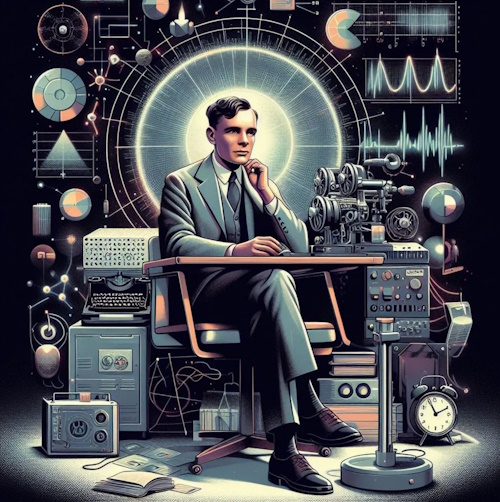
The Turing machine was an abstract mathematical model of computation. It consisted of an infinite tape, a read/write head, and a finite set of states governed by a set of rules. Turing demonstrated that such a machine could perform any computation that could be algorithmically defined. He also showed that there existed problems that no Turing machine could solve, proving that the Entscheidungsproblem was undecidable. This insight not only resolved Hilbert's question but also laid the foundation for the modern theory of computation.
 Turing in America
Turing in America
Turing went to Princeton University in 1936 on a fellowship to study under Alonzo Church, a leading logician and mathematician. Computer pioneer John von Neumann arranged Turing's appointment as Proctor Visiting Fellow after von Neumann previously met Turing during his tenure as Visiting Professor at Cambridge. Church had independently developed the λ-calculus, a formal system equivalent in computational power to Turing's machine model. It was at Princeton where Turing completed his Ph.D. dissertation, titled "Systems of Logic Based on Ordinals." In this work, Turing extended his earlier ideas by exploring the notion of "relative computability" and introducing the concept of "oracles," which could solve problems beyond the capability of standard Turing machines.
Turing also interacted with John von Neumann, another key figure in mathematics and the emerging field of computer science. Von Neumann's work on automata and self-replicating systems resonated with Turing's ideas about computation. These interactions enriched Turing's understanding of computation and influenced his later work on stored-program computers.

While at Princeton, Turing built an electromechanical device for multiplying binary numbers, demonstrating his growing interest in the practical implementation of computational theories. This work foreshadowed his later contributions to the development of electronic computing machines.
 Turing the Mathematician
Turing the Mathematician
Turing's intellectual development was shaped by the broader philosophical and mathematical thinking of his time. Bertrand Russell's work on logic and the foundations of mathematics provided Turing with a formal framework for thinking about computation. Russell's Principia Mathematica, co-authored with Alfred North Whitehead, aimed to reduce mathematics to a set of axioms and rules of inference. Turing's work on the Entscheidungsproblem and the limits of formal systems can be seen as a response to the challenges posed by Russell's program.
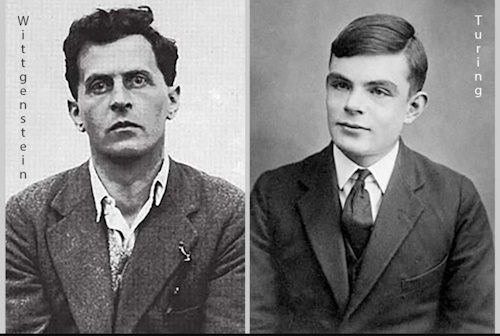
Turing attended Ludwig Wittgenstein's lectures on the philosophy of mathematics at the University of Cambridge. These lectures, later published as Lectures on the Foundations of Mathematics, show the direct interactions between the two thinkers. During these lectures, Wittgenstein posed provocative questions, such as whether mathematical proofs merely compel us to adopt certain rules rather than reveal universal truths.
Turing often challenged Wittgenstein's skepticism, arguing for the validity and objectivity of mathematical structures. Their debates were intense, with Turing pressing Wittgenstein on specific technical points, while Wittgenstein would redirect the conversation to philosophical questions about meaning and use, central tenets of his later philosophy. These debates over the foundations of mathematics, particularly Wittgenstein's criticisms of the reduction of mathematics to logic, pushed Turing to refine his own ideas about computation and the limits of formal systems. They also highlighted the tension between philosophical and practical approaches to logic and computation.
 Turing the Designer
Turing the Designer
Rejecting an offer from von Neumann to be his assistant, Turing returned to Britain from Princeton in 1938, shortly before the outbreak of World War II. He joined the Government Code and Cypher School at Bletchley Park, where he became a central figure in the effort to break German codes. His most significant achievement during this period was the design of the Bombe, an electromechanical machine that automated the process of deciphering messages encoded by the Enigma machine. The Bombe significantly reduced the time required to break Enigma-encrypted messages, providing the Allies with critical intelligence that contributed to the war effort.
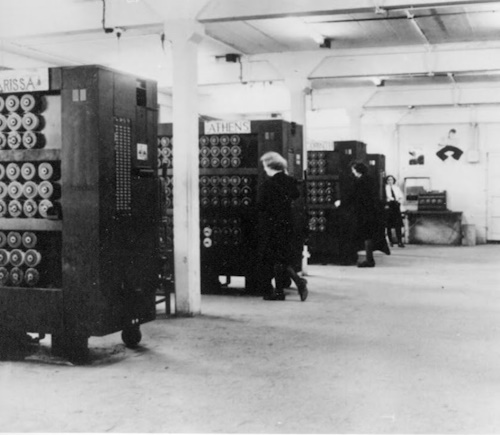
British Bombes
In addition to his work on the Enigma, Turing also contributed to breaking the more complex Lorenz cipher used by the German High Command. His theoretical insights into computation informed the development of Colossus, the world's first programmable digital electronic computer. Although Turing was not directly involved in the construction of Colossus, his pioneering ideas in cryptanalysis and his expertise in cryptography were instrumental in its design and architecture.
Turing's wartime contributions extended beyond cryptography. He also explored the mathematical theory of communication and proposed ideas that prefigured modern concepts in information theory. His work at Bletchley Park not only helped secure an Allied victory but also demonstrated the practical potential of computation.
 Turing the Architect
Turing the Architect
Turing turned his attention from cryptography to the development of general-purpose electronic computers after the war. In 1945, he joined the National Physical Laboratory (NPL), where he proposed the design for the Automatic Computing Engine (ACE). The ACE was based on the stored-program concept, a revolutionary idea that allowed both data and instructions to be stored in the same memory. This architecture, often associated with von Neumann, was inspired in part by Turing's earlier theoretical work on Turing machines. The two pioneers met often, as early as 1935, during Turing's Princeton years, when von Neumann visited Cambridge, and on many other occasions. Some have argued that Turing's universal machine was the seminal idea behind von Neumann's stored program architecture, so revolutionary in the history of computing.
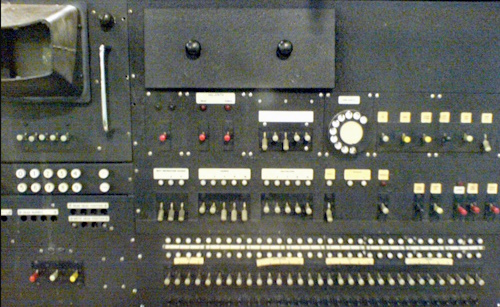
Ace Pilot Console
Turing's ACE design was ambitious, incorporating advanced features such as subroutine libraries and a high-speed processor. Bureaucratic delays and institutional resistance hindered its implementation. Had Turing's ACE been built as he planned, it would have had much more memory than any of the other early computers, as well as being faster. However, his colleagues at NPL thought the engineering too difficult to accomplish, so a much smaller machine was built. That machine, the Pilot Model ACE, was completed in 1950 and it became one of the fastest computers of its time.
 Turing the Programmer
Turing the Programmer
Turing joined the University of Manchester in 1948 as Deputy Director of the Computing Machine Laboratory, where he worked on the Manchester Mark I. The Mark I was one of the earliest stored-program computers and it embodied many of the principles Turing had outlined, including universality and programmability. Turing wrote the first programming manual for the machine and he developed software that demonstrated its capabilities.
During this period, Turing also began exploring the possibility of machine intelligence. His landmark 1950 paper, "Computing Machinery and Intelligence," posed the question, "Can machines think?" In this paper, he introduced the Turing Test, a thought experiment designed to assess a machine's ability to exhibit intelligent behavior indistinguishable from that of a human. The test involves a human evaluator who interacts with both a machine and a human through text-based communication. If the evaluator cannot reliably distinguish between the machine and the human, the machine is said to have passed the test. The Turing Test remains a cornerstone of AI, including discussions of whether today's chatbots pass the test.
Starting in 1951, Turing turned his attention to a field now known as artificial life. He published "The Chemical Basis of Morphogenesis" in 1952, describing aspects of his research on the development of form and pattern in living organisms. Turing used Manchester's Ferranti Mark I computer to model his hypothesized chemical mechanism for the generation of anatomical structure in animals and plants. The Ferranti Mark I was the world's first marketable, stored program electronic digital computer, first delivered in February 1951.
 Legacy and Impact
Legacy and Impact
Alan Turing's contributions to mathematics, computer science, and cryptography have left an indelible imprint on the modern world
His theoretical insights laid the groundwork for the development of digital computers, while his practical achievements demonstrated the transformative potential of computation. Beyond his technical accomplishments, Turing's exploration of machine intelligence anticipated the ethical and philosophical questions that continue to shape the field of AI.
Turing's life was tragically cut short in 1954, but his legacy endures. The Turing Award, established by the Association for Computing Machinery (ACM), is the highest honor in computer science, recognizing individuals who have made lasting contributions to the field. Turing's name also lives on in concepts such as the Turing machine, the Turing Test, and the Turing completeness of programming languages.
Despite his monumental achievements, Turing's life was marred by prejudice and injustice. As a gay man in a time when homosexuality was criminalized in the United Kingdom, Turing faced significant discrimination. In 1952, he was convicted of "gross indecency" and subjected to chemical castration. This treatment not only undermined his personal dignity, but may have contributed to his tragic death in 1954 at the age of 41. Turing's persecution stands as a stark reminder of the societal cost of prejudice and the importance of advocating for equality and human rights.
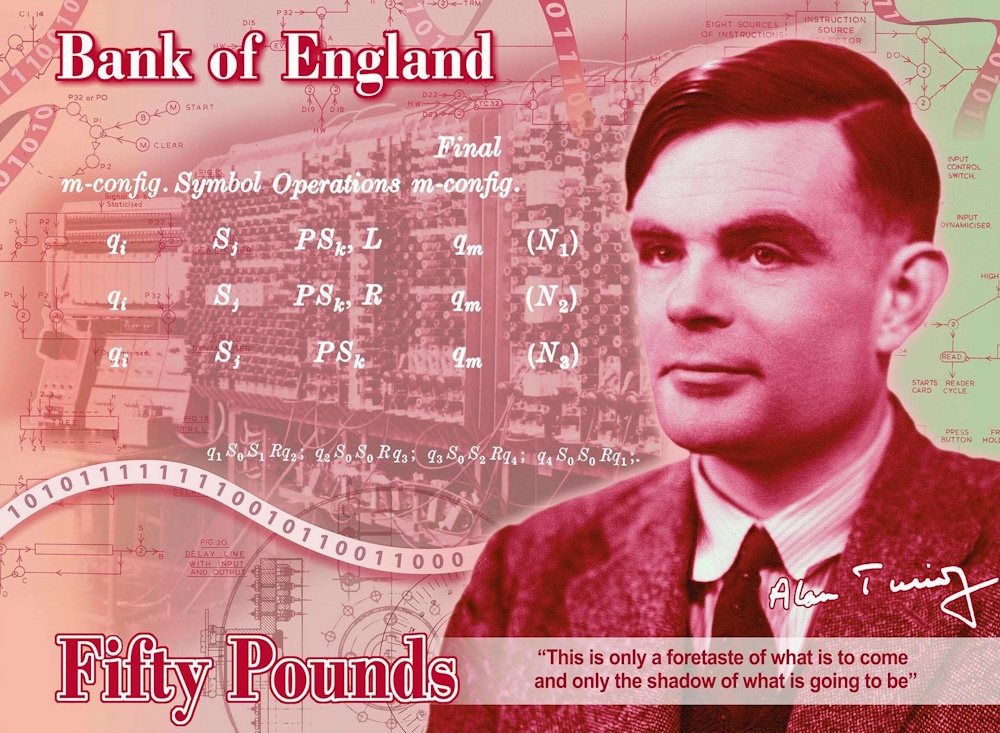
In 2009, following a public campaign, the British government issued an official apology for Turing's treatment, and in 2013, Queen Elizabeth II granted him a posthumous royal pardon. Turing's legacy has since been celebrated, with memorials, books, and films commemorating his life and work. In 2021, his portrait was featured on the 50 pound note in the United Kingdom, symbolizing his enduring impact on science and society, and the BBC named Alan Turing "The Greatest Person of the 20th Century."
 Links
Links
Alan Turing: The Enigma. The Book That Inspired the Film The Imitation Game
The Alan Turing Institute is the UK's national institute for data science and artificial intelligence.